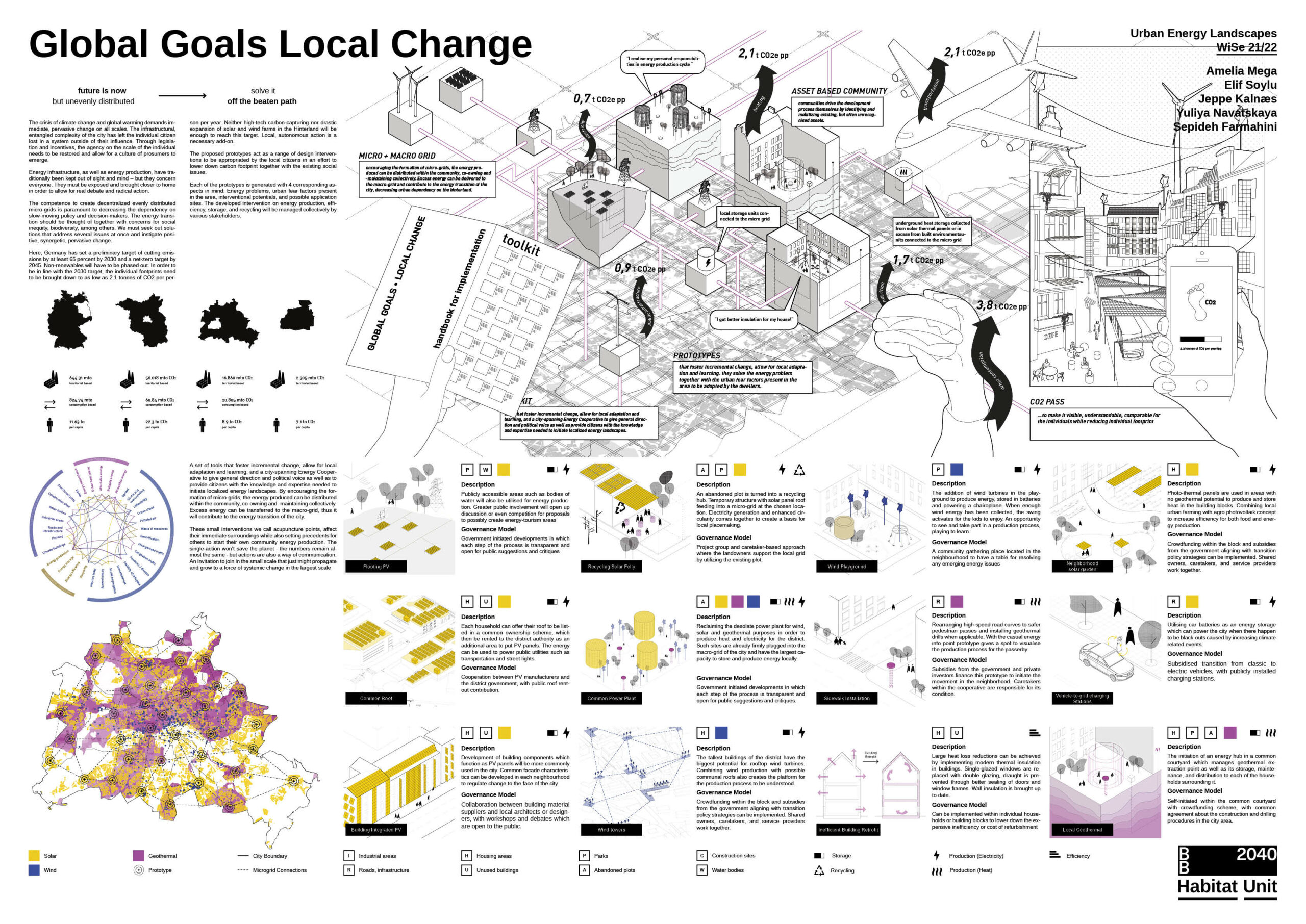Urban Energy Landscapes I Rural Scapes
KIEZ /// INTERMEDIATE
By: Omar Aboutaleb, Mersede Eini, Benjamin Gätzschmann, Sandra Susan Shibu, Jana Wechtenbruch (Group A)
Amelia Mega, Elif Soylu, Jeppe Kalnæs, Yuliya Navatskaya, Sepideh Farmahini Farahani (Group B)
Studio:
“Urban Energy Landscapes”
Prof. Dr. Elke Beyer
Rosa Pintos Hanhausen
David Bauer
Veit Vogel
Habitat Unit WS 2021/22
Energy Mosaic
While the Agora Energiewende gave sufficient qualitative and quantitative evidence on the future of energy landscapes in 2045, the Complex Systems theory on the other hand assumes uncertainty as the main red line (Der Rote Faden) in any of the anticipated scenarios to our urban futures. By 2050, 70% of the population will live in cities. And within the growing urbanization and complexity in the urban systems, innovation - in all its forms - will help support the economic, social, and environmental sustainability of communities during attempts to the energy transition. In which, communities' knowledge and awareness are the forefronts and the response to any potential uncertainties, imposing a special concern on how resilient are the vulnerable social categories (i.e. elderly, marginalized, disabled,...etc).
According to the climate-neutral plan, there is a strong will to push for clean energy sources by 2045 (Agora Energiewende, 2021). Thus, the promotion and transition to wind and solar panels will take up more spaces in our urban realities. The correlation between (1)citizens' reactions (i.e. adaptation, protesting...etc) and (2)the aimed energy targets from these clean energy sources, becomes important. Because the latter provokes citizens' resistance against (and/or collaboration with) other stakeholders over the loss (and/or gain) of their landscape (Lintz, Leibenath, 2021). We can anticipate more conflicts or collaborations between the stakeholder because of the growing and accumulating spatial, social, and technical complexities by 2045. Especially when the discourse on energy will be based on Public-Private Partnerships (PPP) to meet the very special supplies and demands of the different communities. Hence conflicts and/or collaborations will arise as a result of the aforementioned socio-technical-spatial complexities.
Both knowledge through education and awareness, and innovation through technological advancement and thinking influenced each other in our scenarios. Together, they manifested the possible levels of community resilience -or at least community robustness-. While the transition to a different energy source is in itself a socio-technical transition (Geels, 2005), the process includes not only changes in the energy physical and technological infrastructures but the social ones as well. The 2045's climate-neutral plan anticipates more agency to the consumer (citizen) in supervising energy production and consumption. These social accountabilities are seen in the "Entertainment-Education" concept that emphasizes entertainment as a way of social education to deliver a message and collectively make changes in social behaviors (Usdin et.al, 2004). We chose the site around Mauerpark in Berlin Prenzlauer Berg as is most suitable for the "Entertainment-Education" concept due to the already existing parks, stadiums, and other entertainment use.
Innovation might be seen in the innovative ways to store the energy with no compromise needed. Meaning that energy storage infrastructure can simultaneously have different functions that socially, functionally, and spatially coexist; allowing for mutual interactions, education, and entertainment within any attempts for the energy transition in the kiez. Knowledge and awareness on the other hand are seen in the openness and mutuality of the system to diffuse the knowledge and information to attract more participation in the energy transition. An essential step in the process is to bridge the knowledge gap across the different generations, age categories, socioeconomic classes, and ethnicities in the neighborhood.
Global Goals Local Change
The crisis of climate change and global warming demands immediate, pervasive change on all scales. The infrastructural, entangled complexity of the city has left the individual citizen lost in a system outside of their influence. Through legislation and incentives, the agency on the scale of the individual needs to be restored and allow for a culture of prosumers to emerge.
Energy infrastructure, as well as energy production, have traditionally been kept out of sight and mind – but they concern everyone. They must be exposed and brought closer to home in order to allow for real debate and radical action.
The competence to create decentralized, and evenly distributed micro-grids is paramount to decreasing the dependency on slow-moving policy and decision-makers. The energy transition should be thought of together with concerns for social inequity, biodiversity, among others. We must seek out solutions that address several issues at once and instigate positive, synergetic, pervasive change.
Here, Germany has set a preliminary target of cutting emissions by at least 65 percent by 2030 and a net-zero target by 2045. Non-renewables will have to be phased out. In order to be in line with the 2030 target, the individual footprints need to be brought down to as low as 2.1 tons of CO2 per person per year. Neither high-tech carbon-capturing nor drastic expansion of solar and wind farms in the Hinterland will be enough to reach this target. Local, autonomous action is a necessary add-on.
The proposed prototypes act as a range of design interventions to be appropriated by the local citizens in an effort to lower down carbon footprint together with the existing social issues.
Each of the prototypes is generated with 4 corresponding aspects in mind: Energy problems, urban fear factors present in the area, interventional potentials, and possible application sites. The developed intervention on energy production, efficiency, storage, and recycling will be managed collectively by various stakeholders.
A set of tools that foster incremental change, allow for local adaptation and learning, and a city-spanning Energy Cooperative to give general direction and political voice as well as to provide citizens with the knowledge and expertise needed to initiate localized energy landscapes. By encouraging the formation of micro-grids, the energy produced can be distributed within the community, co-owning and -maintaining collectively. Excess energy can be transferred to the macro-grid, thus it will contribute to the energy transition of the city.
These small interventions we call acupuncture points, affect their immediate surroundings while also setting precedents for others to start their own community energy production. The single-action won’t save the planet - the numbers remain almost the same - but actions are also a way of communication. An invitation to join in the small scale that just might propagate and grow to a force of systemic change in the largest scale.
BB2040
[EN] Berlin Brandenburg 2040 was initiated by the Habitat Unit in cooperation with Projekte International and provides an open stage and platform for multiple contributions of departments and students of the Technical University Berlin and beyond. The project is funded by the Robert Bosch Foundation.
[DE] Berlin Brandenburg 2040 wurde initiiert von der Habitat Unit in Kooperation mit Projekte International und bietet eine offene Plattform für Beiträge von Fachgebieten und Studierenden der Technischen Universität Berlin und darüberhinaus. Das Projekt wird von der Robert Bosch Stiftung gefördert.



